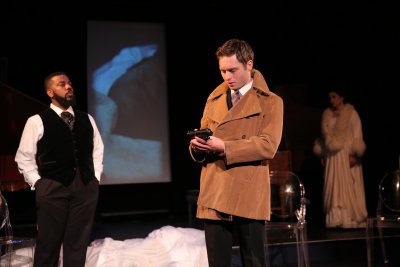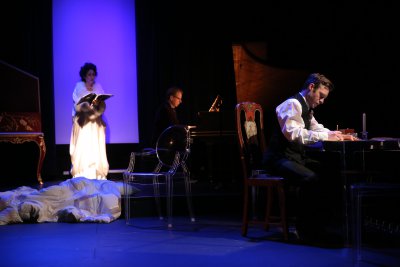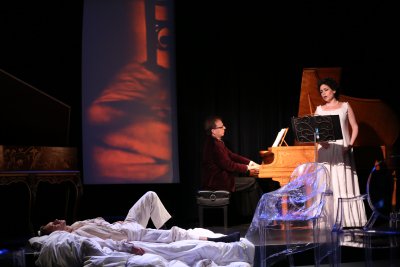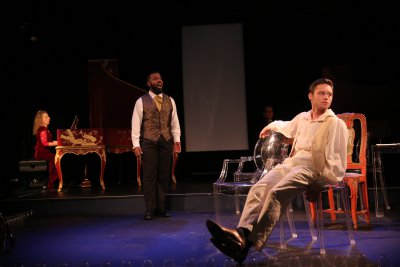Ensemble for the Romantic Century: “The Sorrows of Young Werther”
Intelligently conceived and deftly executed, a wonderful musical and literary love and loss in nineteenth century Germany.

Sidney Outlaw, Bobby Steggert and Rinat Shaham in a scene from Ensemble for the Romantic Century’s “The Sorrows of Young Werther” (Photo credit: Joan Marcus)
[avatar user=”Jean Ballard Terepka” size=”96″ align=”left” ] Jean Ballard Terepka, Music Critic[/avatar] Now in its fourteenth year, the remarkable Ensemble for the Romantic Century, founded by Eve Wolf, has been presenting musical programs of intellectual coherence and imagination, examining themes and subjects central to the development and character of the “long” nineteenth century, from the Enlightenment to the end of the Victorian Era. ERC’s most recent production, The Sorrows of Young Werther, represents the best of this kind of production. Rich and subtle interdisciplinary critical and creative thinking informed the careful merging of a dramatic presentation of Goethe’s novella, The Sorrows of Young Werther with Robert Schumann’s Dichterliebe. The result was an evening of considerable artistic beauty and intellectual rewards.
In 1774, Johann Wolfgang von Goethe (1749-1832) published The Sorrows of Young Werther (Die leiden des jungen Werthers), a novella whose tone and narrative alike became a paradigm of Romantic literature: the young man, Werther, passionate in his thrall to artistic fantasies that cannot be reconciled with reality and hopelessly adoring a woman promised to another, moves from casual speculations about the meaning of life to anguish about the distance of ideals from actual possibilities and finally to suicide. For this production, musicologist and script-writer James Melo has converted Goethe’s prose text into what is essentially a monologue. Throughout the course of the evening, this “monologue” is spoken in extended passages alternating with music.
Close to a century later, in 1840 composer Robert Schumann (1810-1856) set sixteen poems by one of his friends, Heinrich Heine (1797-1856) to music; the result was the Dichterliebe, one of the most beautiful song cycles in the Romantic lied literature.
In Melo’s Sorrows of Young Werther, Dichterliebe songs are interposed in the course of Werther’s monologue. The Goethe-Melo text conveys Werther’s first-person story; the Dichterliebe songs illuminate Werther’s psyche.
Additional layers of context and commentary for this half-spoken, half-sung story of Werther’s love, anguish and death are provided in still more songs that open the work, dovetail with its individual sections and close it. These songs are by German Romantic composers Franz Liszt, Franz Schubert, Johannes Brahms, Hans Pfitzner, Gustav Mahler and Hugo Wolf. Taken altogether, the songs chosen for this production locate the exquisite density of the microcosm of Werther’s spiral towards suicide within the macrocosm of human drama.

Rinat Shaham, Max Barros and Bobby Steggert in a scene from Ensemble for the Romantic Century’s “The Sorrows of Young Werther” (Photo credit: Joan Marcus)
This complex work of text and music was performed by actor Bobby Steggert as Werther, baritone Sidney Outlaw, singing the Dichterliebe and accompanied by pianist Eve Wolf, and mezzo-soprano Rinat Shaham, singing the additional songs and accompanied by pianist Max Barros.
Steggert’s Werther was initially an affable, civilized and convivial fellow, given to intelligent, leisurely and somewhat self-indulgent psychological reflections. His gradual evolution into a man for whom suicide was inevitable was a subtle matter. For an audience, who knows what is coming, Steggert’s likeability made his growing despair hard to discern; only towards the very end, when, in fact, we believe as Werther himself does that he has no option but death, does the genuine turmoil beneath his almost poised and articulate distress become apparent. The credibility of his anguish was less clear during its development than at its conclusion; in this sense, Steggert’s performance, though in the end effective and successful, was uneven, especially at the end of the first half and the beginning of the second half of the work.
Outlaw’s Dichterliebe was gorgeous. In spite of the broken presentation of the songs over the course of the evening, Outlaw conveyed the unity and coherence of Schumann’s work. Outlaw’s musicality and disciplined artistry enabled him to both present the Dichterliebe as a self-contained work of art and sing it as music to enhance the Melo-Goethe text as presented by Steggert. In this sense, Outlaw revealed himself to be an intuitive and collegial actor, working closely with Steggert, even though the two were not in any normal sense characters engaged in dialogue. Outlaw’s voice is large and commanding; nonetheless, he conveyed the psychological intimacy of the lieder with vibrant passion on the one hand and infinite delicacy on the other.
While Outlaw’s musical project involved a single work of art, Shaham’s was different: she was presenting a series of songs by different composers. In that sense, her performance might have been like a chamber music concert. However, because her songs were integrated into the Werther story, they too had to maintain a progress of meaning that enhanced both the Melo-Goethe text and the Schumann music. Shaham’s success in this project was elegant.

Bobby Steggert, Max Barros and Rinat Shaham in a scene from Ensemble for the Romantic Century’s “The Sorrows of Young Werther” (Photo credit: Joan Marcus)
Shaham has an exceptionally rich mezzo voice: it is capable of a wide range of both octaves and volume. Her forte is intense and, even at its most dramatically intense, unforced; her whispered pianissimo is exquisite. In general, Shaham’s narrative strategy for illumination of the macrocosmic drama of the story was to move from a lieder style of singing to something increasingly operatic. The subtle and dynamic shift of styles revealed both Shaham’s virtuosity as a singer and the intelligent coherence of her approach to the songs of diverse composers.
Both Wolf, accompanying Outlaw, and Barros, accompanying Shaham, were marvelous. Like all first-rate accompanists, Wolf and Barros are, in fact, equal partners in music-making. At the very end of the evening, after Werther’s off-stage death, all four musicians – two singers and two pianists – performed together. The return to the core notion of chamber music – of artists creating music together, collaborating in both trust and risk on behalf of the integrity of the music – constituted a fitting conclusion to this imaginative text-and-music account of the story of Werther.
In the small, gracious Leonard Nimoy Theater, set and costume designer Vanessa James and lighting designer Kate Bashore created an uncluttered flexible performance space, evocative of early nineteenth century country-side elegance. Wolf and Barros played beautiful late nineteenth century pianos painted and designed to look considerably older, each set back in the stage space but conforming in style to the evocation of an early Romantic era. In Act I, Steggert and Outlaw wore white Regency era country gentlemen’s clothes; in Act II, they wore darker clothes. Shaham, singing from the edges of the set initially and then, increasingly, starting in the middle of the second act, from its center, wore a white frock that, with accessories, served consecutively as summer dress, formal gown, wedding gown, peignoir and, finally, simply the spare, elegant garb of a woman’s soul.
Hanging from above the center performing space and at the edges of the theater were banners onto which were projected grainy impressionistic photos of nature scenes and the clearly printed, very legible English translations of the German songs. Although the singers’ diction and enunciation were so clear that their German was easy to understand, the translations were very helpful for non-German speaking audience members.

Eve Wolf, Sidney Outlaw and Bobby Steggert in a scene from Ensemble for the Romantic Century’s “The Sorrows of Young Werther” (Photo credit: Joan Marcus)
Much less successful was the series of film projections on a screen at the back of the performing space. These images were disjointed and distracting. Depression era film-clips of dancers waltzing matched the tempo and rhythm of two of the Dicterlieder, but contributed nothing to the narrative. The twice repeated sequence of a naked man watched from behind as he climbs rocks and then dives into deep, fast flowing water detracted from the coherence of the evening’s intellectual project.
By and large the costuming decisions were sane and sensible … with one glaring exception. When Shaham functioned briefly as an unhappy bride-figure, her “veil” was made of clear, floaty plastic … the sort used by dry-cleaners. The symbolic purpose was maddeningly unclear; disconcerting thoughts about “Peligro! This is not a toy!” warnings, accidental suffocations (and one’s dry cleaning) intruded in passing on one’s enjoyment of the music.
In spite of these production design missteps, the evening was intellectually rewarding: ERC presented a graceful and elegant vision and example of German Romantic storytelling, poetry and music. The performing artists, working as a close, effective ensemble, produced a subtle and complex dramatic and musical piece that brought the intimacy of German lieder and chamber music straight into the twenty-first century. It was a wonderful evening.
Ensemble for the Romantic Century: The Sorrows of Young Werther (June 3 and 4, 2015)
Leonard Nimoy Thalia, Symphony Space
2537 Broadway at 95th Street, in Manhattan
For more information, visit http://www.symphonyspace.org or http://www.romanticcentury.org.
Running time: one hour and 55 minutes including an intermission.
Intelligently conceived and deftly executed, a wonderful musical and literary love and loss in nineteenth century Germany.






Leave a comment